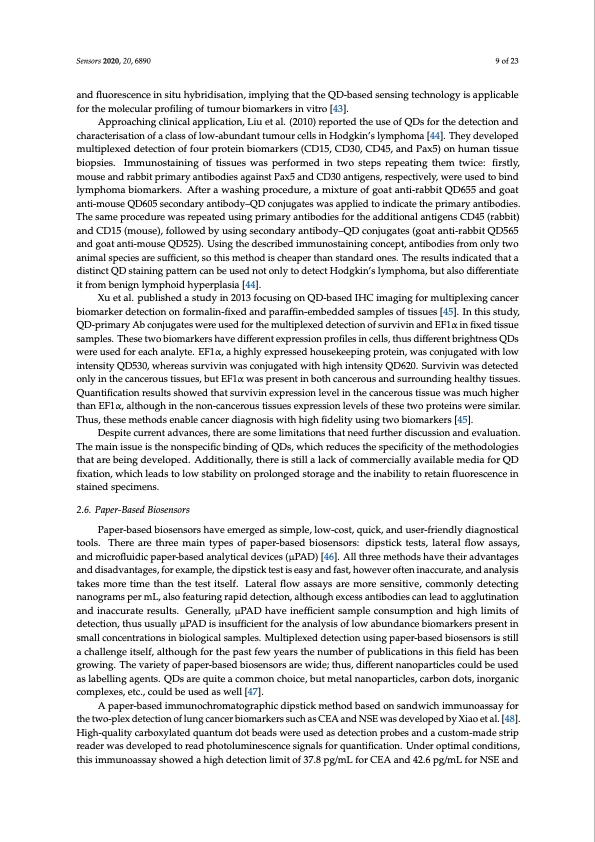
PDF Publication Title:
Text from PDF Page: 009
Sensors 2020, 20, 6890 9 of 23 and fluorescence in situ hybridisation, implying that the QD-based sensing technology is applicable for the molecular profiling of tumour biomarkers in vitro [43]. Approaching clinical application, Liu et al. (2010) reported the use of QDs for the detection and characterisation of a class of low-abundant tumour cells in Hodgkin’s lymphoma [44]. They developed multiplexed detection of four protein biomarkers (CD15, CD30, CD45, and Pax5) on human tissue biopsies. Immunostaining of tissues was performed in two steps repeating them twice: firstly, mouse and rabbit primary antibodies against Pax5 and CD30 antigens, respectively, were used to bind lymphoma biomarkers. After a washing procedure, a mixture of goat anti-rabbit QD655 and goat anti-mouse QD605 secondary antibody–QD conjugates was applied to indicate the primary antibodies. The same procedure was repeated using primary antibodies for the additional antigens CD45 (rabbit) and CD15 (mouse), followed by using secondary antibody–QD conjugates (goat anti-rabbit QD565 and goat anti-mouse QD525). Using the described immunostaining concept, antibodies from only two animal species are sufficient, so this method is cheaper than standard ones. The results indicated that a distinct QD staining pattern can be used not only to detect Hodgkin’s lymphoma, but also differentiate it from benign lymphoid hyperplasia [44]. Xu et al. published a study in 2013 focusing on QD-based IHC imaging for multiplexing cancer biomarker detection on formalin-fixed and paraffin-embedded samples of tissues [45]. In this study, QD-primary Ab conjugates were used for the multiplexed detection of survivin and EF1α in fixed tissue samples. These two biomarkers have different expression profiles in cells, thus different brightness QDs were used for each analyte. EF1α, a highly expressed housekeeping protein, was conjugated with low intensity QD530, whereas survivin was conjugated with high intensity QD620. Survivin was detected only in the cancerous tissues, but EF1α was present in both cancerous and surrounding healthy tissues. Quantification results showed that survivin expression level in the cancerous tissue was much higher than EF1α, although in the non-cancerous tissues expression levels of these two proteins were similar. Thus, these methods enable cancer diagnosis with high fidelity using two biomarkers [45]. Despite current advances, there are some limitations that need further discussion and evaluation. The main issue is the nonspecific binding of QDs, which reduces the specificity of the methodologies that are being developed. Additionally, there is still a lack of commercially available media for QD fixation, which leads to low stability on prolonged storage and the inability to retain fluorescence in stained specimens. 2.6. Paper-Based Biosensors Paper-based biosensors have emerged as simple, low-cost, quick, and user-friendly diagnostical tools. There are three main types of paper-based biosensors: dipstick tests, lateral flow assays, and microfluidic paper-based analytical devices (μPAD) [46]. All three methods have their advantages and disadvantages, for example, the dipstick test is easy and fast, however often inaccurate, and analysis takes more time than the test itself. Lateral flow assays are more sensitive, commonly detecting nanograms per mL, also featuring rapid detection, although excess antibodies can lead to agglutination and inaccurate results. Generally, μPAD have inefficient sample consumption and high limits of detection, thus usually μPAD is insufficient for the analysis of low abundance biomarkers present in small concentrations in biological samples. Multiplexed detection using paper-based biosensors is still a challenge itself, although for the past few years the number of publications in this field has been growing. The variety of paper-based biosensors are wide; thus, different nanoparticles could be used as labelling agents. QDs are quite a common choice, but metal nanoparticles, carbon dots, inorganic complexes, etc., could be used as well [47]. A paper-based immunochromatographic dipstick method based on sandwich immunoassay for the two-plex detection of lung cancer biomarkers such as CEA and NSE was developed by Xiao et al. [48]. High-quality carboxylated quantum dot beads were used as detection probes and a custom-made strip reader was developed to read photoluminescence signals for quantification. Under optimal conditions, this immunoassay showed a high detection limit of 37.8 pg/mL for CEA and 42.6 pg/mL for NSE andPDF Image | Multiplexed Nanobiosensors: Current Trends in Early Diagnostics

PDF Search Title:
Multiplexed Nanobiosensors: Current Trends in Early DiagnosticsOriginal File Name Searched:
sensors-20-06890-v2.pdfDIY PDF Search: Google It | Yahoo | Bing
Turbine and System Plans CAD CAM: Special for this month, any plans are $10,000 for complete Cad/Cam blueprints. License is for one build. Try before you buy a production license. More Info
Waste Heat Power Technology: Organic Rankine Cycle uses waste heat to make electricity, shaft horsepower and cooling. More Info
All Turbine and System Products: Infinity Turbine ORD systems, turbine generator sets, build plans and more to use your waste heat from 30C to 100C. More Info
CO2 Phase Change Demonstrator: CO2 goes supercritical at 30 C. This is a experimental platform which you can use to demonstrate phase change with low heat. Includes integration area for small CO2 turbine, static generator, and more. This can also be used for a GTL Gas to Liquids experimental platform. More Info
Introducing the Infinity Turbine Products Infinity Turbine develops and builds systems for making power from waste heat. It also is working on innovative strategies for storing, making, and deploying energy. More Info
Need Strategy? Use our Consulting and analyst services Infinity Turbine LLC is pleased to announce its consulting and analyst services. We have worked in the renewable energy industry as a researcher, developing sales and markets, along with may inventions and innovations. More Info
Made in USA with Global Energy Millennial Web Engine These pages were made with the Global Energy Web PDF Engine using Filemaker (Claris) software.
Infinity Turbine Developing Spinning Disc Reactor SDR or Spinning Disc Reactors reduce processing time for liquid production of Silver Nanoparticles.
| CONTACT TEL: 608-238-6001 Email: greg@infinityturbine.com | RSS | AMP |